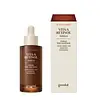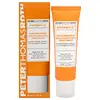What's inside
What's inside
 Key Ingredients
Key Ingredients

 Benefits
Benefits

 Concerns
Concerns

 Ingredients Side-by-side
Ingredients Side-by-side

Water
Skin ConditioningDaucus Carota Sativa Root Extract
Skin ConditioningMethylpropanediol
SolventGlycerin
HumectantDipropylene Glycol
Humectant1,2-Hexanediol
Skin ConditioningCaprylic/Capric Triglyceride
MaskingNiacinamide
SmoothingPolyglycerin-3
HumectantCentella Asiatica Extract
CleansingFicus Carica Fruit Extract
HumectantPhellodendron Amurense Bark Extract
Skin ConditioningPortulaca Oleracea Extract
Skin ConditioningRosmarinus Officinalis Leaf Extract
AntimicrobialChamomilla Recutita Flower Extract
MaskingAvena Sativa Kernel Extract
AbrasiveCynara Scolymus Leaf Extract
Skin ConditioningGlycine Soja Seed Extract
Skin ConditioningHydrogenated Lecithin
EmulsifyingCamellia Sinensis Leaf Water
MaskingSodium Hyaluronate
HumectantCanola Oil
EmollientDaucus Carota Sativa Seed Oil
EmollientHelianthus Annuus Seed Oil
EmollientBetaine
HumectantPhenyl Trimethicone
Skin ConditioningHydroxyethyl Urea
HumectantAmmonium Acryloyldimethyltaurate/Vp Copolymer
Pentaerythrityl Tetra-Di-T-Butyl Hydroxyhydrocinnamate
AntioxidantSodium Acrylic Acid/Ma Copolymer
Ceramide NP
Skin ConditioningXanthan Gum
EmulsifyingEctoin
Skin ConditioningButylene Glycol
HumectantSucrose Distearate
EmollientAdenosine
Skin ConditioningCarbomer
Emulsion StabilisingDisodium EDTA
Tromethamine
BufferingPolyquaternium-51
Skin ConditioningBeta-Glucan
Skin ConditioningGlyceryl Stearate
EmollientRetinol
Skin ConditioningHdi/Trimethylol Hexyllactone Crosspolymer
Propanediol
SolventPolyvinyl Alcohol
Tocopherol
AntioxidantDimethylsilanol Hyaluronate
HumectantHydrolyzed Sodium Hyaluronate
Skin ConditioningHydrolyzed Hyaluronic Acid
HumectantTetrahydropiperine
Skin ConditioningPotassium Hyaluronate
Skin ConditioningPhloretin
AntioxidantHyaluronic Acid
HumectantSodium Hyaluronate Crosspolymer
HumectantHydroxypropyltrimonium Hyaluronate
Sodium Hyaluronate Dimethylsilanol
HumectantSodium Acetylated Hyaluronate
HumectantArginine
MaskingBeta-Carotene
Skin ConditioningTocopheryl Acetate
AntioxidantPhenylpropanol
MaskingEthylhexylglycerin
Skin ConditioningCaprylyl Glycol
EmollientWater, Daucus Carota Sativa Root Extract, Methylpropanediol, Glycerin, Dipropylene Glycol, 1,2-Hexanediol, Caprylic/Capric Triglyceride, Niacinamide, Polyglycerin-3, Centella Asiatica Extract, Ficus Carica Fruit Extract, Phellodendron Amurense Bark Extract, Portulaca Oleracea Extract, Rosmarinus Officinalis Leaf Extract, Chamomilla Recutita Flower Extract, Avena Sativa Kernel Extract, Cynara Scolymus Leaf Extract, Glycine Soja Seed Extract, Hydrogenated Lecithin, Camellia Sinensis Leaf Water, Sodium Hyaluronate, Canola Oil, Daucus Carota Sativa Seed Oil, Helianthus Annuus Seed Oil, Betaine, Phenyl Trimethicone, Hydroxyethyl Urea, Ammonium Acryloyldimethyltaurate/Vp Copolymer, Pentaerythrityl Tetra-Di-T-Butyl Hydroxyhydrocinnamate, Sodium Acrylic Acid/Ma Copolymer, Ceramide NP, Xanthan Gum, Ectoin, Butylene Glycol, Sucrose Distearate, Adenosine, Carbomer, Disodium EDTA, Tromethamine, Polyquaternium-51, Beta-Glucan, Glyceryl Stearate, Retinol, Hdi/Trimethylol Hexyllactone Crosspolymer, Propanediol, Polyvinyl Alcohol, Tocopherol, Dimethylsilanol Hyaluronate, Hydrolyzed Sodium Hyaluronate, Hydrolyzed Hyaluronic Acid, Tetrahydropiperine, Potassium Hyaluronate, Phloretin, Hyaluronic Acid, Sodium Hyaluronate Crosspolymer, Hydroxypropyltrimonium Hyaluronate, Sodium Hyaluronate Dimethylsilanol, Sodium Acetylated Hyaluronate, Arginine, Beta-Carotene, Tocopheryl Acetate, Phenylpropanol, Ethylhexylglycerin, Caprylyl Glycol
Water
Skin ConditioningNiacinamide
SmoothingDimethyl Isosorbide
SolventIsononyl Isononanoate
EmollientTranexamic Acid
AstringentDimethicone
EmollientCaprylic/Capric Triglyceride
MaskingAlpha-Arbutin
AntioxidantCetyl Alcohol
EmollientGlyceryl Stearate
EmollientPentylene Glycol
Skin ConditioningPropanediol
SolventC9-12 Alkane
SolventCitric Acid
BufferingGlyceryl Stearate Se
EmulsifyingButyrospermum Parkii Butter
Skin ConditioningTetrahexyldecyl Ascorbate
AntioxidantKojic Acid
AntioxidantResveratrol
AntioxidantTocopheryl Acetate
AntioxidantDiethylhexyl Syringylidenemalonate
Skin ProtectingHydrangea Arborescens Root Extract
Skin ConditioningMorus Alba Root Extract
BleachingScutellaria Lateriflora Extract
Skin ConditioningHydrolyzed Vegetable Protein
Skin ConditioningSilica
AbrasiveSodium Stearoyl Glutamate
CleansingCoco-Caprylate/Caprate
EmollientDimethiconol
EmollientGlycerin
HumectantSodium Phytate
Potassium Sorbate
PreservativeSodium Benzoate
MaskingCaprylyl Glycol
EmollientHexylene Glycol
EmulsifyingPolysorbate 20
EmulsifyingCeteth-20
CleansingSteareth-20
CleansingPolyacrylate Crosspolymer-6
Emulsion StabilisingPEG-75 Stearate
Titanium Dioxide
Cosmetic ColorantPhenoxyethanol
PreservativeWater, Niacinamide, Dimethyl Isosorbide, Isononyl Isononanoate, Tranexamic Acid, Dimethicone, Caprylic/Capric Triglyceride, Alpha-Arbutin, Cetyl Alcohol, Glyceryl Stearate, Pentylene Glycol, Propanediol, C9-12 Alkane, Citric Acid, Glyceryl Stearate Se, Butyrospermum Parkii Butter, Tetrahexyldecyl Ascorbate, Kojic Acid, Resveratrol, Tocopheryl Acetate, Diethylhexyl Syringylidenemalonate, Hydrangea Arborescens Root Extract, Morus Alba Root Extract, Scutellaria Lateriflora Extract, Hydrolyzed Vegetable Protein, Silica, Sodium Stearoyl Glutamate, Coco-Caprylate/Caprate, Dimethiconol, Glycerin, Sodium Phytate, Potassium Sorbate, Sodium Benzoate, Caprylyl Glycol, Hexylene Glycol, Polysorbate 20, Ceteth-20, Steareth-20, Polyacrylate Crosspolymer-6, PEG-75 Stearate, Titanium Dioxide, Phenoxyethanol
Ingredients Explained
These ingredients are found in both products.
Ingredients higher up in an ingredient list are typically present in a larger amount.
This ingredient is an emollient, solvent, and texture enhancer. It is considered a skin-softener by helping the skin prevent moisture loss.
It helps thicken a product's formula and makes it easier to spread by dissolving clumping compounds.
Caprylic Triglyceride is made by combining glycerin with coconut oil, forming a clear liquid.
While there is an assumption Caprylic Triglyceride can clog pores due to it being derived from coconut oil, there is no research supporting this.
Learn more about Caprylic/Capric TriglycerideCaprylyl Glycol is a humectant and emollient, meaning it attracts and preserves moisture.
It is a common ingredient in many products, especially those designed to hydrate skin. The primary benefits are retaining moisture, skin softening, and promoting a healthy skin barrier.
Though Caprylyl Glycol is an alcohol derived from fatty acids, it is not the kind that can dry out skin.
This ingredient is also used as a preservative to extend the life of products. It has slight antimicrobial properties.
Learn more about Caprylyl GlycolGlycerin is already naturally found in your skin. It helps moisturize and protect your skin.
A study from 2016 found glycerin to be more effective as a humectant than AHAs and hyaluronic acid.
As a humectant, it helps the skin stay hydrated by pulling moisture to your skin. The low molecular weight of glycerin allows it to pull moisture into the deeper layers of your skin.
Hydrated skin improves your skin barrier; Your skin barrier helps protect against irritants and bacteria.
Glycerin has also been found to have antimicrobial and antiviral properties. Due to these properties, glycerin is often used in wound and burn treatments.
In cosmetics, glycerin is usually derived from plants such as soybean or palm. However, it can also be sourced from animals, such as tallow or animal fat.
This ingredient is organic, colorless, odorless, and non-toxic.
Glycerin is the name for this ingredient in American English. British English uses Glycerol/Glycerine.
Learn more about GlycerinGlyceryl Stearate is a mix of glycerin and stearic acid.
It is used to stabilize the mixing of water and oil ingredients. By preventing these ingredients from separating, it can help elongate shelf life. It can also help thicken the product's texture.
As an emollient, it helps soften skin and supports barrier-replenishing ingredients.
In cosmetics, Glyceryl Stearate is often made from vegetable oils or synthetically produced.
This ingredient may not be fungal-acne safe
Fun fact: The human body also creates Glyceryl Stearate naturally.
Learn more about Glyceryl StearateNiacinamide is a multitasking form of vitamin B3 that strengthens the skin barrier, reduces pores and dark spots, regulates oil, and improves signs of aging.
And the best part? It's gentle and well-tolerated by most skin types, including sensitive and reactive skin.
You might have heard of "niacin flush", or the reddening of skin that causes itchiness. Niacinamide has not been found to cause this.
In very rare cases, some individuals may not be able to tolerate niacinamide at all or experience an allergic reaction to it.
If you are experiencing flaking, irritation, and dryness with this ingredient, be sure to double check all your products as this ingredient can be found in all categories of skincare.
When incorporating niacinamide into your routine, look out for concentration amounts. Typically, 5% niacinamide provides benefits such as fading dark spots. However, if you have sensitive skin, it is better to begin with a smaller concentration.
When you apply niacinamide to your skin, your body converts it into nicotinamide adenine dinucleotide (NAD). NAD is an essential coenzyme that is already found in your cells as "fuel" and powers countless biological processes.
In your skin, NAD helps repair cell damage, produce new healthy cells, support collagen production, strengthen the skin barrier, and fight environmental stressors (like UV and pollution).
Our natural NAD levels start to decline with age, leading to slower skin repair, visible aging, and a weaker skin barrier. By providing your skin niacinamide, you're recharging your skin's NAD levels. This leads to stronger, healthier, and younger looking skin.
Another name for vitamin B3 is nicotinamide. This vitamin is water-soluble and our bodies don't store it. We obtain Vitamin B3 from either food or skincare. Meat, fish, wheat, yeast, and leafy greens contain vitamin B3.
The type of niacinamide used in skincare is synthetically created.
Learn more about NiacinamidePropanediol is an all-star ingredient. It softens, hydrates, and smooths the skin.
It’s often used to:
Propanediol is not likely to cause sensitivity and considered safe to use. It is derived from corn or petroleum with a clear color and no scent.
Learn more about PropanediolTocopheryl Acetate is AKA Vitamin E. It is an antioxidant and protects your skin from free radicals. Free radicals damage the skin by breaking down collagen.
One study found using Tocopheryl Acetate with Vitamin C decreased the number of sunburned cells.
Tocopheryl Acetate is commonly found in both skincare and dietary supplements.
Learn more about Tocopheryl AcetateWater. It's the most common cosmetic ingredient of all. You'll usually see it at the top of ingredient lists, meaning that it makes up the largest part of the product.
So why is it so popular? Water most often acts as a solvent - this means that it helps dissolve other ingredients into the formulation.
You'll also recognize water as that liquid we all need to stay alive. If you see this, drink a glass of water. Stay hydrated!
Learn more about Water